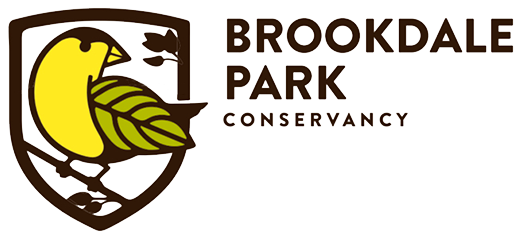by Sarah Paulsen
Awash in sunlight, my living room is a comforting place to start the day. I like watching robins gobble up berries from a chokeberry shrub outside my window. On one particularly chilly morning, my thoughts drifted to chipmunks. These little foragers love chokeberries too, and yet unlike their squirrel cousins, they vanish in winter.
Where did the chipmunks go? Their absence made me wonder—not just about their winter habits, but for a critter who loves the park as much as we do, what sort of role do they play in the health of our park? I spent the next several hours reading up on what makes the chipmunk tick.
The Eastern Chipmunk (Tamias striatus) is a small rodent in the squirrel family and the only chipmunk native to the eastern United States. It thrives in the woods, suburbs and urban parks. With its black-and-white striped sides, chubby cheeks, and diminutive size, it is undeniably cute. But don’t be fooled by its charm—this little creature is a tireless worker.
Like many animals, its life work revolves around food. Chipmunks are omnivores. They forage for nuts, berries, seeds, mushrooms, insects, and occasionally baby birds and eggs. Our park’s mature oaks provide one of its most prized foods: acorns. A single chipmunk can haul over 150 acorns back to its burrow in a day. Their cheeks, which can stretch up to three times the size of their head, act as built-in grocery bags for transporting their loot.
Aside from mating season in the fall and spring, chipmunks prefer to go it alone. Their well-designed burrows are 1 ½ to 3 feet underground and can run 10 to 30 feet long. The entrance is camouflaged. Inside, they have different chambers for food storage and sleeping and all is kept tidy. They line the interior with leaves and other plant matter. Larder hoarders, they store all their food in a centralized location: their burrow. This behavior makes them less suited to helping new trees germinate versus squirrels who cache food in multiple locations - forgetting some of them means some acorns inevitably germinate.
Unlike true hibernators, chipmunks don’t sleep through the winter. Instead, they enter a state of torpor, waking periodically to nibble on their stored provisions. They rarely leave the burrow in winter which explains why they aren’t out foraging for my chokeberries.
But chipmunks do far more than collect acorns. Foraging and digging tunnels helps aerate the soil and disperse seeds. Their droppings spread a beneficial fungus that enhances nutrient and water uptake for trees and plants. And as a prey species, they sustain the park’s owls, hawks, raccoons, and foxes.
Of course, life is precarious for a creature so low on the food chain. To survive, chipmunks rely on their speed, agility, and a network of hideaways like rock walls and brush piles. They also have an extensive repertoire of vocals to communicate. Have you ever startled a chipmunk and heard them make a high-pitched squeal? That warns of a ground predator (you). Researchers have also discovered another call that warns of predators in the sky.
So, on that chilly morning, when I looked out at the chokeberry shrub and wondered about the chipmunks, I set off on a journey into their fascinating world. In their short lifespan of 2 to 3 years, these small, industrious creatures play an outsized role in keeping Brookdale Park’s ecosystem thriving. Though out of sight in winter, they are never truly gone. Hidden beneath our feet, curled up in their carefully constructed burrows, they are waiting—like the acorns they hoard—for the warmth of spring to call them back into action.
Just for fun check out the life of a chipmunk in Georgia
Photo credits: G Gonthier, J. St John
HOLD THESE DATES!
Learn about adding native plants to your garden with Yuliya Bellinger on 3/13 at 7PM on zoom. Registration details will be emailed closer to the date.
Our first community volunteer day will be 3/18. Help us with spring cleaning, email to register.
Sarah serves as a board trustee at the Brookdale Park Conservancy, focusing on habitat restoration and community outreach. She is committed to fostering sustainable land management, connecting communities with nature, and contributing to environmental conservation.






